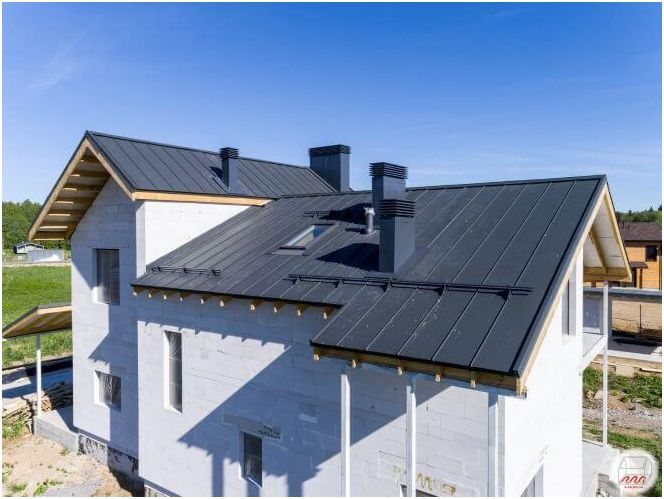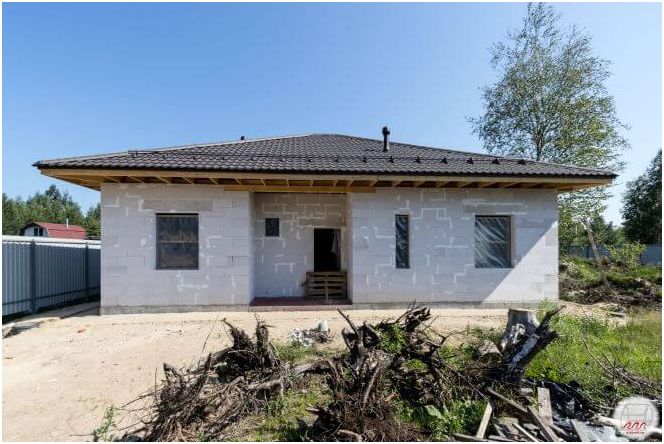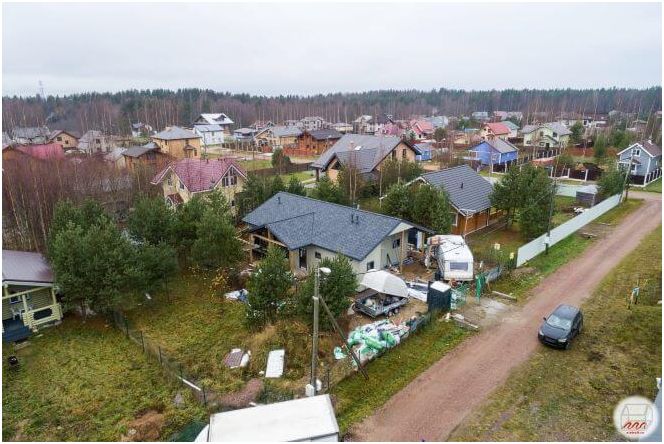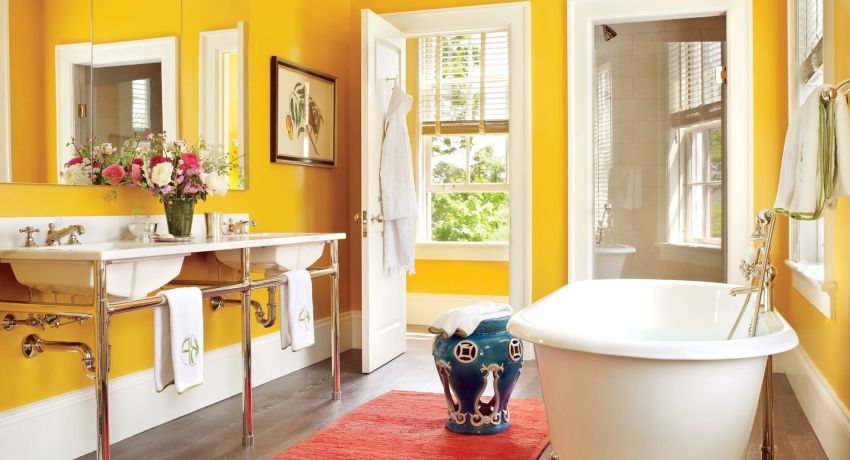In the process of building country houses or cottages, each owner will have to choose roofing materials. Roof is a concept that includes “roofing pie” and the pillars connecting the load-bearing walls and roofing. If we talk about the correct overlapping of the roof of a private house, then it is important to carefully study the issue of arranging the roofing cake and lathing. Before carrying out the work on the overlap, the coating material is selected, on which not only the construction budget depends, but also the parameters of the lathing, the laying method and other points.
Basically, the roof has two functions. Firstly, it increases the visual value of the roof surface, and secondly, it protects the construction timber of the truss and roof from adverse weather conditions and pests. Currently, the owners have a lot of doubts about which type of overlap to choose. Consider what kind of roofing floors are and how not to be mistaken with the choice.
Reinforced concrete or timber roof slab?

In Russia, for a long time in buildings made of wood or stone, wooden materials were used to create floors. They are still used in the construction of private houses today. To extend the life of wooden materials, modern compounds are used, ranging from antifungal to fire-fighting impregnations. Despite this, reinforced concrete floor slabs are safe, durable, multifunctional.
The roof overlap is carried out using reinforced concrete slabs with a length of 1.5 to 12 meters. It is possible to manufacture plates with an accuracy of 1 centimeter. The standard thickness of the products is 200 mm, and the width is from 1.2 to 1.5 meters. Inside the reinforced concrete slabs, the floors leave voids, thereby reducing the cost of manufacturing products, as well as their weight. This simplifies the installation process..
Roof slab – types of materials

Even 20-30 years ago, the choice of materials for the roof was limited to slate, galvanized iron or roofing material. Each owner knew all the advantages and disadvantages of these coatings. Today, the list of building materials has expanded significantly. They differ in type, technical characteristics, cost..
Sheet roofing
This category includes corrugated board, metal, slate, ondulin, as well as seam roofing. Let’s consider each type of building materials in more detail.
Corrugated board
For the manufacture of profiled metal sheets, galvanized steel is used. The corrugated board varies in color, is aesthetically pleasing, the sheets do not have much weight, and can be easily mounted on the roof. If the installation of the roof overlap with this coating is performed correctly, taking into account the technology, then the durability of the building material is up to 50 years. At the same time, as a result of damage to the sheet, corrosion forms in these places..
Among the disadvantages of building materials: noise during the rain (noise insulation is required), rapid heating in the sun. The material is often used to cover the roofs of outbuildings, industrial premises.
Metal tile
It is a cold-rolled steel sheet to which several layers of protective coating are applied. Visually, such a building material resembles ceramic tiles. The building material is mounted on the crate with the help of self-tapping screws, while linings are necessarily used. Taking into account the low weight of the metal tile, the efforts of one person are enough for high-quality laying..
The metal tile is easy to transport, the low cost of the material makes it affordable for every person. Among the disadvantages are poor sound insulation, as well as a lot of waste. Metal tiles are used in private and industrial construction.
Slate
The most affordable building material of all roofing materials on the market. It is 85% Portland cement and 15% asbestos. The weight of a standard corrugated slate is 10-15 kilograms, the length is 1.75 meters, and the width is in the range of 980-1130 mm. Sheets come in six-, seven- and eight-wavelengths. Slate is laid with a roof slope of 10-60 °. During the laying process, it is important to ensure that the sheets overlap in 1-2 waves. As a lathing, square bars are used (section 5 cm, step 50-55 cm). Also, during installation, a gasket made of glassine or roofing material is used..
Slate is used to cover barns, toilets, and other outbuildings. Overlapping private houses with slate is important in situations with a limited construction budget. The service life of slate is 30-40 years. Among the advantages:
- Mechanical impact strength.
- Ease of processing (easily cut with a conventional angle grinder).
- Low price.
- Incombustibility.
Among the disadvantages are fragility, high hygroscopicity (the material accumulates moisture, which causes moss to form on it). Also, asbestos is unsafe for humans..
Seam roof

Overlapping the roof of a house with a seam roof is applied in relation to pitched roofs. These are flat sheets of metal, fastened to each other by folding (lock joints formed by bending). There are single and double folds on the market. For the production of building materials, sheet steel or galvanized material is used. Less commonly used aluminum or copper sheets.
For installation, a wooden crate with an anti-condenser coating is preliminarily created. The sheets are laid in two stages:
- Formation of stripes that are equal to the length of the ramp.
- Lifting strips to the roof where the connection takes place.
A special tool is used for folding. The material has many features, ranging from fire resistance, unhindered water flow, ending with frost resistance, low weight, the ability to cover non-standard roofs. Among the disadvantages – the need for additional insulation, sound insulation, labor-intensive installation.
Ondulin
Natural material. The production uses fine cellulose fibers impregnated with bitumen and polymer additives. Ondulin is also called Euroslate. After staining with heat-resistant polymer paint, ondulin becomes aesthetic. Leaf weight – 6.5 kilograms, length – 2 meters, width – 0.96 meters.
The material is used to cover garages, baths, sheds. Ondulin is a good solution for difficult roofs, as it bends easily. With its help, it is convenient to carry out the reconstruction of old slate roofs..
Soft roof
This category includes roof overlays such as shingles, roll-to-roll guided roofing and flat membrane roofing..
Flexible shingles
Practical, functional, durable roofing material. Flexible shingles are attractive. The line includes building materials in different colors and shapes. With the help of different types of flexible roofs, it is possible to create rectangular, hexagonal, oval and other roof shapes. Flexible shingles are resistant to mechanical damage, moisture, mold, temperature extremes, pollution. The building material can be operated at temperatures from -45 to 110 degrees, excellent for almost any region of Russia.
If the installation is done correctly, flexible shingles will last more than 50 years. At the same time, in case of deformation of one of the roof elements, it is possible to perform a simple, prompt replacement, without the need to shift the entire row. Among the shortcomings, one can single out the high cost of roofing material, as well as strict requirements for temperature conditions during the installation process..
Roll guided roofing
One of the most practical coatings. Roll roofing is generally available, has a low price, ease of installation, excellent insulating properties. Modern roll roofing is a durable, strong material that competes with other products. By design, it is a base (fiberglass / fiberglass material or special cardboard), impregnation agent, protective powder, as well as lower layers.
Membrane flat roof
Coatings with many benefits. The following types of such materials are presented on the market:
- PVC. In production, polyvinyl chloride is used, which is used in the production of films for waterproofing. Improving the characteristics of building materials is provided by a reinforcing mesh, as well as various plasticizers. PVC membranes make it possible to create coatings on which seams are practically invisible.
- EPDM. More modern and expensive membranes. The production uses ethylene propylene diene monomer (synthetic rubber). Such roofing coverings have a service life of up to 60 years..
- TPO. Innovative coatings with unique properties. They are characterized by flexibility and durability. The only drawback of such coatings is the high cost..
Roofing membranes do not have a backing, therefore they are flexible, lightweight and thin materials.
Rare types of roofs

Hip roofs are rarely created in Russia. By design, such a roof is four equal triangles that are connected at the top point. Such structures are applied in relation to buildings in the form of a square. Such an overlap looks attractive, for the arrangement it will be necessary to create a specific rafter system.
With a multi-gable roof, the structure is even more complex. It is characterized by external ribs and internal corners located at the junction of the slopes. Professionals are always involved in the construction of such roofs. A multi-gable roof is created for houses with a polygonal shape, with the presence of side attics, as well as additional outbuildings.
In some cases, a dome-type roof is used to cover part of the structure. During the arrangement, a frame is created using curved elements. Roofing material, bituminous tiles and other soft materials, as well as steel, plastic tiles and other flexible building materials can be used in the structure..
Soffits for roofing

Soffits – facing material for filing the lower planes of the overhangs of structures. This element gives the structure aesthetics, and the result is preserved for many years, without additional maintenance costs. Soffit – these are separate panels that are fixed to the box along the edge of the roof, while the panels are joined together by means of special locking joints. The panels allow you to hide electrical wiring and communications, as well as other elements of the house, which negatively affect the aesthetics of the facade. These elements are used in construction, as well as in the reconstruction or repair of houses. There are siding spotlights on the market, as well as wood panels. Each of the types of spotlights has certain visual qualities, as well as special useful properties..
The first type of soffit is wooden, it is recommended for the facades of classical buildings. Most often, a soffit of this shape is made from larch, spruce or pine. For the manufacture of wooden soffits, boards with a thickness of no more than 20 mm are usually used. The peculiarity of the wooden soffit is that it must be properly fixed. So, after manufacturing, it is painted with good quality varnish. Only then will the wooden ceiling be reliably protected from adverse weather conditions such as excessive sunlight and humidity. In the case of a wooden soffit, it is important to remember about systematic maintenance of it. It is necessary to repaint the soffit at least once every five years..
The situation is different with vinyl siding soffits, which are currently the most widely used in Russia. This type of soffit is very resistant to changing weather conditions and is especially easy to install. PVC soffit manufacturers, taking care of the individual expectations of their customers, produce and sell it in many colors.

